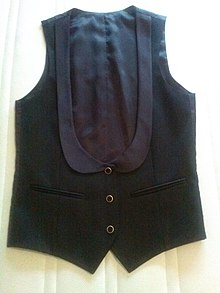
Wool barathea evening waistcoat with silk collar and jig, giving a surface that is lightly pebbled or ribbed, with the effect of a twill running both left and right. Originally developed as a cloth for mourning clothes in the 1840s, it took several decades to become popular for other purposes, due to its association with bereavement. [1]
The yarns used are various combinations of wool, silk and cotton. Worsted barathea (made with a smooth wool yarn) is often used for evening coats, [2] such as dress coats, dinner jackets, and military uniforms, [3] in black and midnight blue. Silk barathea, either all silk, or using cotton weft and silken warp, is widely used in the necktie industry. [4]
References
- ^ MacLochlainn, Jason (2011). The Victorian Tailor: An Introduction to Period Tailoring. St. Martin's Griffin. p. 49. ISBN 9780312642334.
- ^ Flusser, Alan (2002). Dressing the Man: Mastering the Art of Permanent Fashion. HarperCollins. p. 278. ISBN 0-06-019144-9.
- ^ "MIL-C-3727F, Military Specification for Cloth, Barathea, Wool". U.S. Department of Defense. 1987-12-18. Retrieved 2013-12-04.
-
^ Frank P. Bennett (1914).
A Cotton Fabrics Glossary.
Guilford, Ct.: Frank P. Bennett & Co. pp.
684.
Barathea.